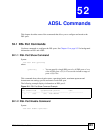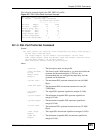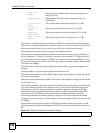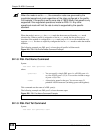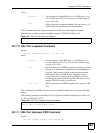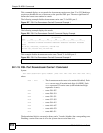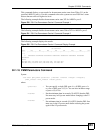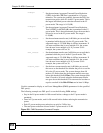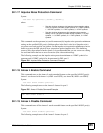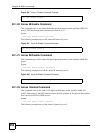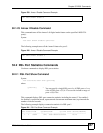
Chapter 52 ADSL Commands
IES-612-51A User’s Guide
351
The hexadecimal digit is converted to binary and a '1' masks (disables) the corresponding tone.
Disabling a carrier tone turns it off so the system does not send data on it.
This command displays or sets masks for upstream carrier tones from 0 to 63. Masking a
carrier tone disables the use of that tone on the specified DSL port. Use this command to have
the system not use a DSL line’s tones that are known to have a high noise level. The most
significant bit defines the lowest tone number in a mask.
The most significant bit defines the first tone sequentially. For example, in <m0>, 0x00000001
means tone 31. For example, you could use 0xffff0000 for <m0> to disable upstream carrier
tones 0~15 and leave tones 16 ~ 31 enabled.
The following example disables upstream carrier tones 0~15 for DSL port 5.
The following example displays the results.
52.1.14 DSL Port Downstream Carrier0 Command
Syntax:
ras> adsl dscarrier0 <port number> [<m1> <m2> <m3> <m4> <m5> <m6> <m7>]
where
The hexadecimal digit is converted to binary and a '1' masks (disables) the corresponding tone.
Disabling a carrier tone turns it off so the system does not send data on it.
Figure 225 DSL Port Upstream Carrier Command Example
ras> adsl uscarrier 5 ffff0000 00000000
Figure 226 DSL Port Upstream Carrier Command Display Example
ras> adsl uscarrier 5
us carrier
port m0 m1
---- |--------|--------|
5 FFFF0000 00000000
Tone:
m0:0-31, m1:32-63
<m1> - <m7> =
The downstream carrier tones to be masked (disabled). Each
<
mx> can use up to 8 hexadecimal digits (0~ffffffff). Each
<
mx> represents 32 carrier tones (each hexadecimal digit
represents 4 tones).
<m1> =
tones 32~63
<m2> =
tones 64~95
<m3> =
tones 96~127
<m4> =
tones 128~159
<m5> =
tones 160~191
<m6> =
tones 192~223
<m7> =
tones 224~255



